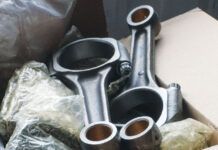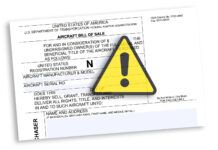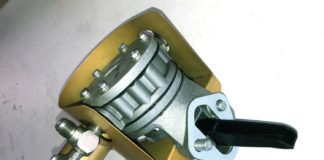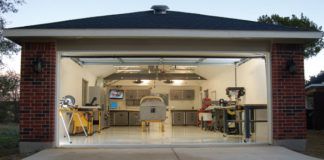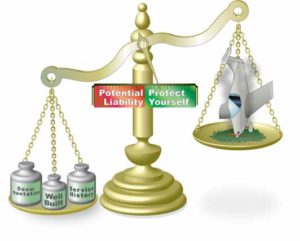 You labored long and hard building your perfect plane. You flew it, enjoyed it, and along the way demonstrated the safety of your beloved aircraft. Now, though, its time to let go of the beloved, for whatever reason. Someone new will own and fly it-maybe other owners and pilots will follow. None who follow will ever feel the way you do about this aircraft, and none will ever match the investment in blood, sweat and tears you put into the plane. But you’ve heard hangar-flying talk about the risk of being sued out of house, home and other worldly possessions should some subsequent pilot crash in the plane you built.
You labored long and hard building your perfect plane. You flew it, enjoyed it, and along the way demonstrated the safety of your beloved aircraft. Now, though, its time to let go of the beloved, for whatever reason. Someone new will own and fly it-maybe other owners and pilots will follow. None who follow will ever feel the way you do about this aircraft, and none will ever match the investment in blood, sweat and tears you put into the plane. But you’ve heard hangar-flying talk about the risk of being sued out of house, home and other worldly possessions should some subsequent pilot crash in the plane you built.
Should You Sell It?
So you’re unsure of the wisdom-the safety, if you will-of selling the aircraft that bears your name as the manufacturer. In hangar-flying sessions in my past, some pilots went so far as to suggest they would destroy their creations before letting another owner make them a target for some greedy ambulance-chasing attorney.
Of course, in most cases the pilot doesn’t have-never had-an aircraft in play that he’d built himself; in the one case where the speaker actually had built an airplane, he had no thoughts of ever selling it. It’d be his kids problem someday, he joked. While wildly exaggerating the issue, talk like this does reflect a popular view of lawyers and lawsuits and courts-a view tinted by a touch of paranoia.
Well, step back, take a deep breath, exhale, and relax. According to a number of attorneys, such suits against are-and virtually never successful. Assuming you built wisely, followed directions where available, employed accepted methods and practices otherwise, and sold an airplane that demonstrated its airworthiness throughout your time of safe, smart flying, the chances of you becoming the target of a liability lawsuit are, were told, nearly nonexistent.
Even with this history of safe flight behind you, however, there are other steps you should take to help shield yourself from the possibility of such a lawsuit-steps that can aid in your defense should even this unlikely event occur.
Protection Starts in the Shop
Builders of Experimental aircraft typically go to great lengths to assure the integrity of their projects with great attention to elements that may serve to protect themselves and any occupants in the event of an accident. But some of those same diligent builders may overlook the need for protection when they sell their beloved homebuilts. That lack of protection could make the seller the target of legal action.
As noted, suits filed against builders are not common-the number ever filed, one lawyer said, is miniscule. Further, it appears that no successful actions have ever been taken against a builder, something thats bound to be disappointing to potential plaintiffs. But in winning, a defendant builder can face bills totaling tens of thousands of dollars even if the win comes without a trial through a dismissal or directed verdict.
So following accepted and proven building practices, documenting your care and skill, and then taking some simple steps to protect yourself could be worth thousands downstream. Unfortunately, not even these steps-in fact, no steps-can keep someone from filing a lawsuit if a lawyer is willing to take the case. Unless the plaintiffs lawyer strongly believes the case is a winner, however, the plaintiff may spend thousands to support the lawyers efforts. If the lawyer believes in the cases potential, taking the case on a contingency basis is possible.
The Legal Contingency
You’ve undoubtedly seen the television ads touting legal help at no cost to you unless we win. Well, thats a contingency case and they are not at all uncommon in cases where a big insurance policy or big assets combine with a strong case to entice the lawyer to proceed without a guarantee of payment. Even then, the plaintiff may be on the hook for incidentals such as copying fees, filing fees and other costs.
But it’s unusual for a pilot selling a homebuilt to be attractive to a lawyer, because the pilot lacks the financial assets that make contingency cases attractive. So following some steps can help close the door on the suits progress and possibly give your lawyer ammunition to get the suit dismissed in your favor. Unfortunately, even that simple defense can cost, but the expense will be lower than a full-court defense or losing a lawsuit.
Well examine the basics you can employ to protect yourself and why you need to do so. Because liability laws vary from state to state, be sure you consult with an attorney on the use of any generic forms you might get from a pilot group, kit company, a self-help Internet site, computer program-or even this article. A lawyer licensed in your state is your best bet for crafting adequate protection from a liability suit related to a plane you built and sold.
Torts 101-An Open-Door Concept
On the first day of Torts in law school, my lawyer friends like to say, comes lesson number one: Anyone can sue anybody for anything at anytime. This doesn’t mean the plaintiffwins anything-some of those anything suits never get past the preliminary hearing. Others die shortly after, victims of legal maladies ranging from a lack of assets to recover from the defendant to insufficient evidence or merit.
Nonetheless, too often suits get filed despite the unlikelihood of prevailing, and along the way the defendant often winds up paying just to later see the suit tossed. This situation is but one reason to take steps to insulate yourself.
The builders of Experimental aircraft, one legal group noted recently, are a potentially fertile field for liability suits. That means a segment of attorneys, scouting for new territory in which to sue, believe the explosion in registered Experimental/Amateur-Built aircraft will eventually lead to an increase in lawsuit prospects they can pursue.
These lawyers cite as foundations for their belief that some kit companies seem to have ssets worth pursuing. They also believe some builders will have assets worth pursuing, such as savings accounts, mutual fund or stock holdings, or a liability insurance policy. A builder with assets-say a large net worth or other assets-may be a more attractive target for a plaintiffs attorney, but even someone with little more than a home could theoretically be a target.
At least one aviation insurance company, Avemco, offers a policy that extends so-called third-party liability protection to the builder of an aircraft after it has been sold. The terms and length of coverage vary according to how long the original builder kept the airplane before selling it. The builder also during the period of ownership. Thats one option for erecting a little protection against a lawsuit.
Warranties and Promises: The Stuff of Lawsuits
Disappointed customers turned lawsuit plaintiffs often cite a breach of warranty when suing a seller of goods or services. Under general tort theory, there are three bases for lawsuits, attorneys explain: strict liability, warranty or negligence, and there can be different shadings of those.
Under strict liability, sale of a defective product that is unreasonably dangerous to the user could get you sued. In general, though, individuals are not legal targets for claims under strict liability, because strict liability applies to businesses making or selling goods directly to users.
Under warranties, there are three distinct types: implied warranty of fitness for a purpose, implied warranty of merchantability and express warranty; the seller, by offering an item for sale, also guarantees the suitability and safety of the product, generally in writing.
For our purposes, the implied warranty is the one most likely to draw legal action. Under the theory of implied warranty, the buyer depends on the seller for a judgment that the product will provide the service sought. Avoiding the implied warranty claim is the reason you see contracts with wording such as sold with no warranties, express or implied, or sold as-is or with these faults accepted by the buyer, and buyer assumes all risk.
The possession of such a liability waiver signed by the buyer cant guarantee that you wont get sued by a disappointed buyer or surviving family members of a person injured or killed. But it can aid in the defense and, possibly, result in a dismissal-unless, that is, the plaintiff can document some sort of negligence on your part.
Unlike the liability an aircraft company can face from a claim of negligence-that is, the company failed to take all possible steps to protect the buyer from harm from the product-individual builders are required only to show they used reasonable care when building the airplane. Documentation for the FAA and logs showing that you followed the kit makers instructions can help you fight a negligence claim-if not a suit itself.
Dealing with Implied Warranty
If you’ve ever taken a demo ride in a factory or show plane during some special flying event or demo day at your home field, you likely signed a waiver, or liability release, that essentially says you wont blame the pilot or the aircraft owner if something goes wrong, and that you know and accept the risks you face during the flight. You may have signed a similar document when buying your kit or a factory-built airplane, one that waives any liability on the part of the seller. In some states, this liability release may say you agree not to sue or that you’ll accept binding arbitration in the event of a disputed accident.
Despite the generally plain language, these waivers and liability releases are not necessarily a guarantee you wont get sued, but they can be used in your defense, showing that the plaintiff both knew the risks and accepted them. The best thing you can do to protect yourself as the manufacturer of the airplane is to follow the building instructions, document your reasonable care and require the buyer to sign a sales contract that includes such a release of liability.
Other Evidence for the Defense
The fact that an airplane you built has flown successfully and safely for years before you sold it can be evidence of the aircrafts suitability for its purpose long after the sale. Ditto for subsequent years of condition inspections conducted after the sale for subsequent owners. After all, the longer the plane worked without an incident, the more it points toward the aircraft s fitness for flight.
If the aircraft changes hands several times before a pilot prangs it and sues, you have further evidence that the airplane you built was suitable for fulfilling the needs of several other owners before it got into the hands of the current owner.
One bit of investigative material you cannot count on, however, is the finding of an investigation by the National Transportation Safety Board. By law, the NTSBs deliberations and reports cannot be used as evidence by plaintiffs or defendants in a lawsuit. The reason for this exclusion is that Congress wanted to ensure as much as possible the accuracy of information used in the NTSB investigation. If witnesses, pilots, and engine and airframe makers had to worry that their information could be used against them in court, they would well be less willing to participate in crash inquiries
Another area of possible defense is, as yet, untested for homebuilt aircraft: the so-called statute of repose created for aircraft by federal law, the General Aviation Revitalization Act of 1994. Under the theory of the clause, the safe use of an airplane for 18 years is considered irrefutable documentation that a design and its installed equipment are safe. Items included under the statute of repose include the airframe, avionics, electrical components, instruments, gauges, engine and prop. The 18-year limit essentially relieves the original manufacturer of liability after the time has passed.
Replace or rebuild any item, and the clock resets to zero for that component. So the manufacturer of a 40-year-old airplane would be immune from liability, but not the company that overhauled the engine last year-nor the engine company that provided a replacement engine installed within the past 18 years.
Unfortunately for the Experimental aircraft crowd, the language of the law starts the 18-year clock running upon delivery to a customer by the original manufacturer. Because builders, not kit makers, are the manufacturers, the theory goes, the clock doesn’t start running until the original builder sells the plane to another party.
That theory could change as a result of an original builder successfully using the 18-year statute of repose as a defense in a liability lawsuit. So, the attorneys say, a properly crafted liability release remains a builders best protection against a liability suit.








